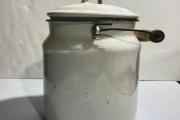The longest train trip I have even taken, and which I have now taken five times, was the three-day journey between Cape Town, South Africa and Salisbury, Southern Rhodesia. The first time was in 1957, when my mother and we three children had just arrived by boat from England. We were met in Cape Town by my father, who had gone ahead of us to Southern Rhodesia, where he was now working for the Rhodesia Railways. Because of this very fact, though I didn’t know that then, he was entitled to free or hugely reduced rail travel in Rhodesia and in South Africa, too. So, he had, in fact, come down by rail to Cape Town, from Southern Rhodesia, to meet us, and to accompany us, on that same journey, in reverse, to our new home.
Cape Town was beautiful, with its stunning backdrop of Table Mountain, its blue skies, exotic plants, and its Dutch style of architecture, with almost horse-shoe shaped roofing, curving outwards at the edges. The colours were vibrant: low buildings with red and green roofs, and with wide verandas, sporting highly polished red concrete floors; red squirrels, luscious flowers, such as the tall canna of all shades, and beautiful trees in the numerous parks, so different from all that we were used to seeing in the endless grey of battered, crumbling, post-war Britain.
I was too young to notice, I suppose, the stark separation, legislated by a system called apartheid, between the different races, though by the time I took my third trip to Cape Town, when I was in my twenties, I couldn’t believe how marked the delineation was. Africans were kept away as much as possible from Whites, though they worked for Whites as “house boys”, “garden boys” (demeaning terms for adult workers, I now realize), and in the service industry, all menial jobs, poorly paid. Blacks were required by law to live in separate “townships”, far away from the affluent white residential areas. Africans had to carry a pass, or “stupa”, which showed where they lived and worked. People of colour could be stopped by police at any time, demanding to see their stupa. Failure to show it could result in being arrested. Some buses were for Whites Only, others for Blacks Only. Even benches in parks were similarly designated. Shops did not allow Africans to use the front entrance. The beautiful railway station in Cape Town had an impressive front entrance, but also a rear entrance which Blacks were required to use. Of course, they were allowed to travel, but only in the poorest class of transportation, and in the worst of conditions. Whites, however, were the privileged race, who had the best of everything. Truly appalling, but I was too young, at nine years of age, to notice what was going on around me in this beautiful city. I was interested only in seeing my father again for the first time in several months, and in absorbing all the sights and sounds, including that of Afrikaans being spoken around me.





Alison Watson3 years ago
Loved the characteristics of each train trip, especially the Japanese, who are a standout in organizational, when travelling.
Susan Leadlay3 years ago
Thank you for your comment, Alison. I am so glad you enjoyed my descriptions of the very different styles of travel by train, all well known to me.
Susan